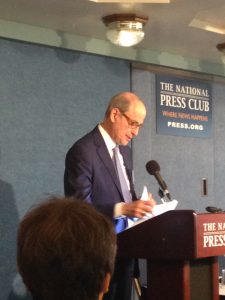

The American Academy of Arts and Sciences (AAAS) delivered its final report on the future of language education to the U.S. Congress, recommending “a national strategy to improve access to as many languages as possible for people of every region, ethnicity, and socioeconomic background.”
“America’s Languages: Investing in Language Education for the 21st Century,” which was produced in response to a bipartisan request from senators and representatives in 2014, recommends that we “value language education as a persistent national need similar to education in math or English, and to ensure that a useful level of proficiency is within every student’s reach.”
Congress will be pleased to hear that the report does not call for “massive increases in funding at the local, state or federal levels,” according to Paul LeClerc, director of Columbia University’s Global Center in Paris and chair of the Academy’s Commission on Language Learning.
“Our greatest challenge, as our final report highlights in detail, is one of teaching capacity,” said LeClerc. “The Commission recommends ways to organize existing resources so that we can teach more Americans to speak more languages at an earlier age. We also want to make sure that language education is available to people of every cultural and socioeconomic background.”
The Commission’s five recommendations are:
-
Increase the number of language teachers at all levels of education so that every child in every state has the opportunity to learn a language in addition to English.
-
Encourage the coordination of state credentialing systems so that qualified teachers can find work in regions where there are significant shortages.
-
Attract talented and enthusiastic language teachers through federal loan forgiveness programs.
-
Develop and distribute online and digital technologies, as well as blended learning models, particularly in communities with a short supply of language teachers.
-
Provide new opportunities for advanced study in languages in higher education—for future language teachers as well scholars in other fields—through a recommitment to language instruction, blended learning programs, and the development of new regional consortia allowing colleges and universities to pool learning resources.
-
-
Supplement language instruction across the education system through public-private partnerships among schools, government, philanthropies, businesses, and local community members.
-
Draw on local and regional resources by working with heritage language communities and other local experts to create in-school and after-school instructional programs.
-
Maintain support for state humanities councils and other organizations that create vital language and cultural resources for local communities.
-
-
Support heritage languages already spoken in the U.S., and help these languages persist from one generation to the next.
-
Encourage heritage language speakers to pursue further instruction in their heritage languages.
-
Provide more language learning opportunities for heritage speakers in classroom or school settings.
-
Expand efforts to create college and university curricula designed specifically for heritage speakers and to offer course credit for proficiency in heritage language.
-
-
Provide targeted attention to Native American languages.
-
Increase support for the use of Native American languages as the primary languages of education, and for the development of curricula and education materials for such programs.
-
Provide opportunities for Native Americans and others to study Native American languages in English-based schools with appropriate curricula and materials.
-
-
Promote opportunities for students to learn languages in other countries, by experiencing other cultures and immersing themselves in multilingual environments.
-
Encourage high schools and universities to facilitate learning abroad opportunities for students.
-
Increase the number of international internships sponsored by businesses and NGOs.
-
Restructure federal financial aid to help low-income undergraduates experience study abroad during the summer as well as the academic year.
-
According to the report, the commission as a whole believes that instructional opportunities in other languages should be offered as early in life as possible. Its primary goal is that every school in the U.S. offer meaningful instruction of languages other than English as part of their standard curricula. Such a recommendation should have a significant effect on school boards considering the expansion of dual-language programs and the introduction of languages into the preK-6 curriculum.
The commission is also suggesting colleges and universities offer beginning and advanced language instruction to all students, and reverse recent cuts “wherever possible.” It also applauds recent efforts to expand undergraduate language requirements.
Currently, 44 states and Washington, D.C., report that they can’t find enough qualified K-12 teachers to meet current needs, but all districts respond to shortages in different ways, the commission says. So, it calls for federal loan forgiveness plans for Direct Loans to attract qualified teachers.
“The Commission’s work was thoughtful, extensive, and critical to the future of our nation,” said Martha G. Abbott, executive director of the American Council on the Teaching of Foreign Languages (ACTFL). “In the weeks and months ahead, ACTFL will work tirelessly along with the entire language profession through a national public awareness campaign, Lead with Languages, to encourage action by local, state, and federal leaders, as well as university, corporate and nonprofit partners, to gain a national commitment to language learning,” she continued.
The report, which is available at http://www.amacad.org/language, is a crucial step in the creation of an educational infrastructure capable of overcoming America’s monolingualism, and thus enable its citizens to reap the wide range of benefits associated with bi- and multilingualism.





